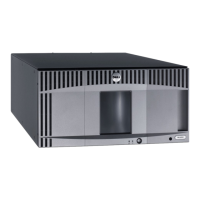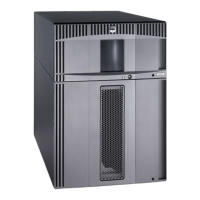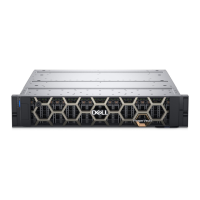Getting Information
file:///T|/htdocs/stor-sys/ML6000/en/html/ch06.htm[9/17/2012 1:49:55 PM]
• WWNN—World Wide Node Name of the blade.
• CCL— Command control LUN.
• Status/State—The status of the blade can be: Ready, Not Ready, Auto Level Failed, Auto Leveling Booting, and
Unknown.
The paths to open the appropriate screens are as follows:
• From the Web client, select Tools > I/O Blade Info.
• From the operator panel, select Tools > Blade Info.
Viewing FC I/O Blade Port Information
Administrators can view information about all the FC I/O blades installed in the library. The Tools - Blade Port Information
screen lists the following port information for each FC I/O blade:
• Port number — The port number: 1–6.
•
WWPN
— World Wide Port Name of the port.
• Status — The status of the blade: Config wait, Loop init, Login, Ready, Lost Sync, Error, Re-Init, Non part, and Failed.
• Actual Speed — Negotiated speed of the port: 1 Gb/s, 2 Gb/s, or 4 Gb/s. If the port is not in a ready state, "N/A"
displays.
• Actual Loop ID — Negotiated loop ID of the port: 0–125. On the web client, if the port connection type is Point to
Point, or if the port is not in a ready state, "N/A" displays. On the operator panel, if the port is not in a ready state,
"N/A" displays.
• Requested Speed — Requested speed of the port: Auto, 1 Gb/s, 2 Gb/s, 4 Gb/s, or 8 Gb/s (Web client only).
• Requested Loop ID — Requested loop ID of the port: Auto or 0–125 (Web client only).
• Framesize — Framesize setting of the port: 528, 1024, or 2048.
• Mode — Mode of the port: Public or Private.
• Role — Role of the port: Target (ports 1–2) or initiator (ports 3–6).
• Connection — Connection type of the port: Loop, Point to Point, or Loop Preferred.
For information about configuring FC I/O blade ports, see
Configuring FC I/O Blade Ports.
The paths to open the appropriate screens are as follows:
• From the Web client, select Tools > I/O Blade Port Info.
• From the operator panel, select Tools > Blade Info > Port Info.
Back to Contents Page

